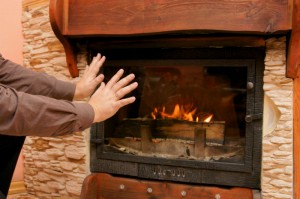Most homeowners view having a fireplace as a low-cost way to add extra heat and warmth to their homes during the cold winter months. However, many fail to realize that their fireplaces may be wasting more energy than they’re creating.
As a fire burns, the heat rises up the chimney, causing cold air to rush down to replace it. This can cause frigid air to enter a house even as a fire is burning, negating the effects of the fireplace entirely. Thankfully, there are several products available to help improve fireplace system efficiency, preventing the loss of hot air and maximizing the warmth fireplaces provide.
Fireplace doors
While somewhat ineffectual at improving fireplace efficiency while a fire is burning, fireplace doors are an attractive way to seal off the fireplace from the rest of the house. Doing this prevents cold downdrafts of air from entering from the chimney as well as prevents warm air from escaping from the room.
Available in a variety of styles to fit any budget and home décor, many homeowners find that professionally fitted glass doors add an attractive aesthetic aspect to their fireplaces. While fitted glass doors should never be completely closed when a wood burning fireplace is in use, they serve as both an eye-catching focal point as well as a way to improve efficiency when the fireplace is not in use.
Firebacks
A fireback is a heavy piece of wrought iron, cast iron, or other metal that is placed at the back of the fireplace. This placement serves two purposes. First, it reflects heat away from the chimney and back into the room. Second, it prevents the masonry or stonework at the back of the fireplace from any damage.
Available in a variety of decorative styles, firebacks are an easy way to improve fireplace efficiency without making a major change or renovation to the structure of the existing fireplace.
Dampers
A damper is the metal plate that separates the chimney from the firebox itself. While all dampers fit snugly when first installed, they can lose their airtight seal due to warping over time. Although it is possible for a homeowner to install a damper, it is recommended to have a new damper professionally installed. Because dampers are exposed to heat from the firebox on one side and cold air, wind, and snow from the chimney on the other, it is extremely important that they are correctly installed so they do not cause a loss in efficiency.
While dampers should always be open when a fire is burning, keeping dampers tightly closed when the fireplace is not in use can prevent a loss of heat from the house as well as keep moisture and cold air from entering the firebox.
Fireplace inserts
A fireplace insert is a fireproof box that is surrounded by steel or cast iron with a glass front panel. This creates a closed combustion system, trapping the heat in the fireplace before it can escape up the chimney. Because of this, inserts more efficiently heat the rooms they are located in; the addition of a blower to the fireplace insert makes them an extremely valuable heat source.
As technology moves forward, so does the efficiency of fireplace inserts. Current inserts can be powered by a number of fuel sources, including wood, gas, propane, electricity, pellets, and even coal. These differing options of fuel sources offer homeowners a variety of choices and the ability to select an insert that truly meets their unique needs.
While inserts represent the most energy efficient option for most fireplaces, it is extremely important to only install inserts approved by the Environmental Protection Agency. Doing this ensures that your new insert has actually been tested to be energy efficient and will not pose a safety threat to your family.

